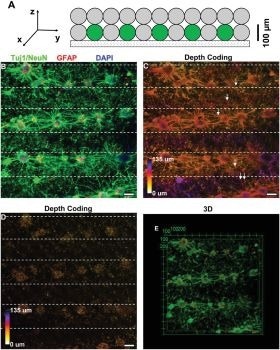Researchers from Monash University’s Engineering Department have achieved a significant breakthrough by using “bioinks” that include living nerve cells (neurons) to 3D print nerve networks. These printed networks can be cultured in a lab, send and receive nerve signals, and even respond to them.
 Bioprinted cortical neurons and astrocytes after in vitro culture at 7DIV. A) Cross-section view of bioprinted structure consisting of cellular (green) and acellular (grey) strands. B) Maximum intensity projection of patterned structure: cellular–acellular–cellular. Neurons (NeuN, green), astrocytes (GFAP, red), and nuclei (DAPI, blue) were colocalized and developed complex structures. Axons (Tuj1, green) originating from the proximal cellular strands projected across the distal cellular strand. C) Depth-coding of Tuj1/NeuN showed the development of axonal projections across strands. White arrows indicate neurites that belong to different focal planes. D) Depth-coding of DAPI shows localization of cell nuclei. E) Confocal image in 3D. Depth-coding was represented using a color bar: red, closest to the glass substrate, and blue, 135 µm away from the substrate. Scale bar, 100 µm. Image Credit: Monash University
Bioprinted cortical neurons and astrocytes after in vitro culture at 7DIV. A) Cross-section view of bioprinted structure consisting of cellular (green) and acellular (grey) strands. B) Maximum intensity projection of patterned structure: cellular–acellular–cellular. Neurons (NeuN, green), astrocytes (GFAP, red), and nuclei (DAPI, blue) were colocalized and developed complex structures. Axons (Tuj1, green) originating from the proximal cellular strands projected across the distal cellular strand. C) Depth-coding of Tuj1/NeuN showed the development of axonal projections across strands. White arrows indicate neurites that belong to different focal planes. D) Depth-coding of DAPI shows localization of cell nuclei. E) Confocal image in 3D. Depth-coding was represented using a color bar: red, closest to the glass substrate, and blue, 135 µm away from the substrate. Scale bar, 100 µm. Image Credit: Monash University
They accomplished this through tissue engineering and bioprinting, employing two types of bioinks: one with living cells and the other with non-cellular materials. This allowed them to replicate the structure found in the brain, including both grey and white matter.
Professor John Forsythe, who led the research, pointed out that previous studies relied on two-dimensional nerve cell cultures to explore nerve network formation and disease mechanisms. However, these flat structures do not accurately represent how neurons naturally grow and interact within their environment.
The networks grown in this research closely replicated the 3D nature of circuits in a living brain, where nerve cells extend processes called neurites to form connections between different layers of the cortex.”
John Forsythe, Professor, Department of Materials Science and Engineering, Monash University
Professor John Forsythe adds, “We found that the projections growing from neurons in the printed ‘grey matter’ or cellular layer readily grew through the ‘white matter’ layer and used it as a ‘highway’ to communicate with neurons in other layers. Not only were we able to construct a basic layout similar to what we see in regions of the brain, we found that the neurons actually behaved and performed in a similar manner.”
Sensitive electrophysiological measurements verified that the 3D neuronal networks exhibited spontaneous nerve-like activity, alongside responses triggered by electrical and drug stimulation.
The detection of electrical activity within these tissue-engineered 3D networks marks a noteworthy advancement in both neuroscience and bioprinting.
These bioprinted 3D neural networks hold great promise as a platform for studying the development and growth of nerves and nerve networks, examining the impact of certain diseases on neurotransmission, and screening the effects of drugs on nerve cells and the nervous system.
Source:
Journal reference:
Yao, Y., et al. (2023). Three‐dimensional Functional Neuronal Networks in Free‐Standing Bioprinted Hydrogel Constructs. Advanced Healthcare Materials. doi.org/10.1002/adhm.202300801.